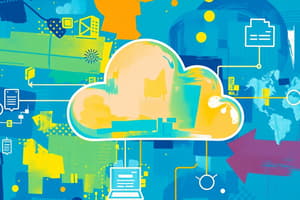Podcast
Questions and Answers
What is a primary responsibility managed by cloud providers for consumers?
What is a primary responsibility managed by cloud providers for consumers?
- Providing customer support for software issues
- Developing custom applications for users
- Data analysis of user behavior
- Performing backups and system maintenance (correct)
What is a key benefit of multitenancy in cloud solutions?
What is a key benefit of multitenancy in cloud solutions?
- Increased hardware costs
- Shared resources in virtual isolation (correct)
- Reduced customization options for each user
- Unified application development
What issue can arise from using SaaS applications without proper browser security?
What issue can arise from using SaaS applications without proper browser security?
- Enhanced data privacy
- Increased software performance
- Risk of data compromise from malicious websites (correct)
- Improved application reliability
Which of the following is a disadvantage of using SaaS applications?
Which of the following is a disadvantage of using SaaS applications?
What is a drawback concerning portability in SaaS environments?
What is a drawback concerning portability in SaaS environments?
Which of the following describes a benefit of Open SaaS?
Which of the following describes a benefit of Open SaaS?
When employees face issues logging into systems, what is a common problem related to user credentials?
When employees face issues logging into systems, what is a common problem related to user credentials?
What is a suggested method to mitigate browser-based risks while accessing SaaS applications?
What is a suggested method to mitigate browser-based risks while accessing SaaS applications?
What is a primary challenge consumers face when storing data in the cloud?
What is a primary challenge consumers face when storing data in the cloud?
What distinguishes a Type 1 hypervisor from a Type 2 hypervisor?
What distinguishes a Type 1 hypervisor from a Type 2 hypervisor?
Which of the following statements is true regarding virtualization?
Which of the following statements is true regarding virtualization?
What is the role of a hypervisor in virtualization?
What is the role of a hypervisor in virtualization?
Which of the following is NOT a requirement consumers have for cloud storage?
Which of the following is NOT a requirement consumers have for cloud storage?
Which of these is an example of a Type 2 hypervisor?
Which of these is an example of a Type 2 hypervisor?
What is the best description of a guest machine?
What is the best description of a guest machine?
Which of the following correctly defines cloud storage?
Which of the following correctly defines cloud storage?
Which type of hardware virtualization allows guest software to run without any modifications?
Which type of hardware virtualization allows guest software to run without any modifications?
In which type of virtualization do the guest operating systems operate in isolated domains without hardware simulation?
In which type of virtualization do the guest operating systems operate in isolated domains without hardware simulation?
What is a primary concern regarding cloud computing security?
What is a primary concern regarding cloud computing security?
Which cloud service model requires the consumer to be responsible for some aspects of security?
Which cloud service model requires the consumer to be responsible for some aspects of security?
What should be analyzed prior to deploying a resource to the cloud?
What should be analyzed prior to deploying a resource to the cloud?
Which component does VMware vSphere virtualize?
Which component does VMware vSphere virtualize?
In the context of cloud security, what does the Cloud Security Alliance (CSA) stack model define?
In the context of cloud security, what does the Cloud Security Alliance (CSA) stack model define?
What is an essential action when transferring data in cloud environments?
What is an essential action when transferring data in cloud environments?
What functionality does the Chatter app provide for employees?
What functionality does the Chatter app provide for employees?
Which Google service allows users to create and collaborate on documents?
Which Google service allows users to create and collaborate on documents?
What is the primary function of Quickbooks?
What is the primary function of Quickbooks?
Which application provides a drag-and-drop service for file storage?
Which application provides a drag-and-drop service for file storage?
How does Mozy assist users during data loss?
How does Mozy assist users during data loss?
What is a unique feature of Evernote?
What is a unique feature of Evernote?
What is the primary use of Audiobox.fm?
What is the primary use of Audiobox.fm?
Which social networking service is primarily known for brief updates and public interactions?
Which social networking service is primarily known for brief updates and public interactions?
What does Identity as a Service (IDaaS) primarily manage?
What does Identity as a Service (IDaaS) primarily manage?
Which of the following is NOT a service typically included in IDaaS?
Which of the following is NOT a service typically included in IDaaS?
What is the main function of Single Sign-On (SSO) software in user authentication?
What is the main function of Single Sign-On (SSO) software in user authentication?
Which statement best describes the process of SSO?
Which statement best describes the process of SSO?
What happens to a user's access when they leave the company if using an SSO system?
What happens to a user's access when they leave the company if using an SSO system?
What does Federated Identity Management (FIDM) allow users to do?
What does Federated Identity Management (FIDM) allow users to do?
How does the authentication server function within Single Sign-On?
How does the authentication server function within Single Sign-On?
Which of the following best defines 'identity' in the context of IDaaS?
Which of the following best defines 'identity' in the context of IDaaS?
Study Notes
Cloud Provider Responsibilities
- Cloud providers handle all platform responsibilities, including backups, system maintenance, security, hardware refresh, and power management.
- Consumers are relieved from these operational tasks and can focus on their applications.
Multitenant Solutions
- Multitenancy enables multiple users to utilize a single instance of resources while maintaining virtual isolation.
- Consumers can customize applications without disturbing core functionalities.
SaaS Issues
- Browser-based risks can compromise consumer data if accessed via infected browsers. Using multiple browsers can mitigate this risk.
- SaaS requires constant network availability, and reliability cannot be guaranteed by either the provider or the consumer.
- Portability issues arise when transferring workloads between different SaaS clouds due to provider-specific workflows and interfaces.
Open SaaS and SOA
- Open SaaS applications are developed using open-source programming and compatible with any open-source operating system and database.
- Benefits include no licensing fees, low deployment costs, reduced vendor lock-in, portability, and robustness.
Identity as a Service (IDaaS)
- IDaaS simplifies identity management and electronic transactions, addressing challenges like remembering multiple credentials.
- Key features of IDaaS include directory services, federated services, registration, authentication, risk monitoring, single sign-on, and identity management.
Single Sign-On (SSO)
- SSO streamlines user access by allowing a single login to authenticate access across multiple systems.
- The SSO process involves a user logging into the authentication server, receiving a ticket, and using that ticket to access other servers.
Federated Identity Management (FIDM)
- FIDM facilitates the packaging of security credentials across different security domains, enhancing user mobility across services.
Challenges of Cloud Storage
- Consumers face challenges including the ability to provision storage on demand, control over data location, verification of data erasure, and access to hardware disposal processes.
- Administrator access control is crucial for data management.
Virtualization
- Virtualization enables resource sharing among multiple organizations by creating logical names for physical resources.
- It allows for the creation of virtual machines (VMs) that are separate from the underlying hardware.
Hypervisors
- Hypervisors are critical for managing virtual machines and come in two types:
- Type 1 (bare-metal hypervisors) runs directly on hardware without a host OS.
- Type 2 (hosted hypervisors) runs on existing operating systems emulating device interactions.
Types of Hardware Virtualization
- Full Virtualization simulates the entire underlying hardware without needing guest software modifications.
- Emulation Virtualization allows VMs to operate independently of the actual hardware configuration.
- Paravirtualization enables guest software to manage their own isolated domains without hardware simulation.
Cloud Computing Security
- Security is paramount; data must be stored encrypted and should utilize proxy or brokerage services for protection.
- Prior to resource deployment, assess the sensitivity, the required cloud service model, and the specific cloud type.
- The risk assessment is influenced by the selected service models and cloud types.
Applications in Cloud Services
- Collaboration: Chatter enables real-time sharing of organizational information.
- Productivity: Google Apps offer tools for document collaboration; QuickBooks provides online accounting.
- Data Storage and Backup: Services like Box.com and Mozy provide flexible file management and backup solutions.
- Management Applications: Tools like Toggl and Evernote help with time tracking and note organization.
- Social Applications: Platforms such as Facebook and Twitter facilitate social networking and updates.
- Entertainment Applications: Audiobox.fm allows for online music streaming.
Conclusion
- Cloud computing encompasses a broad range of services and applications, integrating security and technology effectively to address consumer needs and enhance operational efficiency.
Studying That Suits You
Use AI to generate personalized quizzes and flashcards to suit your learning preferences.
Related Documents
Description
Explore the key responsibilities managed by cloud providers, including backups, system maintenance, and security. Understand the concept of multitenancy and how it enables multiple users to share resources while maintaining application customization. This quiz will enhance your knowledge of these essential cloud computing principles.




